HEBE FOR THE UK GARDENER
Article by David Marks
Hebe are evergreen shrubs and, depending on the variety, grow from 20cm / 8in to 1.2m / 4ft high and roughly the same spread. They originate from New Zealand and Northern America. Use the checklist below to decide if a
Hebe is suited to your garden conditions.
Note that hardiness is generally good for Hebes in the UK but some varieties are more hardy than others, this is noted in the section below entitled Varieties of Hebe.
Use the checklist below to decide if a Hebe is the correct plant for you and your garden:
- They prefer full sun throughout the year but will also grow very well in semi-shade. In very low light conditions the plant will become leggy and may not produce flowers.
- Grow equally well in open ground and containers.
- They grow well in soil which is slightly acidic through to slightly alkaline, conditions which will be found in almost UK gardens. They can grow on light and heavy clay soils. They do not grow well in water-logged ground and prefer well-drained soils.
- When grown in open ground they only require watering in very dry conditions. When grown in containers they will need more frequent watering from May to September.
- Hebes tolerate neglect well mainly because their nutrient requirements are low and they grow well with minimal pruning.
- Some produce attractive flowers, many are variegated and all are evergreen.
- They rarely suffer from pests or diseases unless completely neglected.
- The shorter varieties tolerate wind well and also grow well in coastal areas having good salt-tolerance.
NOTE: Some of the pictures below are from the Hebe Society, UK with their permission. For more information on the Hebe Society, please click here. Many thanks to them for the pictures.
HOW TO CARE FOR A HEBE
Hebes are relatively low maintenance shrubs but a small amount of attention will ensure that they perform to the best of their abilities. The following care plan will help them do just that:
- In March examine the plant for signs of frost damage. Prune away any frost damaged stems back to a healthy bud. This can be done at the same time as the annual prune (see below).
- If your hebe is a flowering variety, dead head any flowers as they begin to shrivel up, this will extend the flowering period considerably.
- Hebes in open ground should not be fed nitrogen rich fertilisers, they don't respond well to that. But they will appreciate a feed in April and July with a handful of blood, fish and bone scattered around them and gently worked into the ground.
- When grown in open ground hebes should only be watered in very dry periods. Water well if needed but not often.
PRUNING HEBES
An annual prune will do your hebes a power of good. It will keep the plant to a reasonable size and, especially with taller varieties, stop stems bending over and crowding the centre. If the annual pruning is neglected, most hebes will eventually become bare at the base with all the foliage at the top of the plant.
- March is a good time to prune a hebe because new buds will be visible.
- Never prune back into old dead wood, always prune back so that at least a couple of buds are still present on each stem.
- With shorter and more compact varieties only prune to maintain a good shape. Removing the top 5cm / 2ins is about right.
- With taller varieties prune back the top 20cm / 8in or so. Pruning a few stems back further (but always leaving two buds) will open up the centre of the plant and encourage new, colourful growth.
GROWING HEBES IN CONTAINERS
The main need for growing hebes in containers is to water them so that the compost is kept moist but not water-logged. Rainwater collected from a water butt is the best source of water for hebes in containers.
From April to September a feed once every two months with a small handful of blood, fish and bone worked into the surface of the compost. In winter place the plants where they out of the wind and have some frost protection – against the wall of a heated house will do fine or in an unheated greenhouse.
Many varieties of hebe are eminently suitable for growing in containers because the majority not only produce flowers but also have interesting foliage. From our own personal experience we have recommended a few tried and trusted varieties, these can be found at the end of this article here.
HEBE PESTS AND DISEASES
Hebes are remarkably healthy plants but they do suffer from a few diseases in particular.
LEAF SPOT OF HEBES
Known officially as Septoria Leaf Spot, this causes small brown marks on the leaves. There is no immediate effect on the plant but if left to its own devices this disease will significantly reduce the vigour of the plant and cause it to grow leggy.
This fungal disease is most noticeable in October to February. In March time when new leaves begin to develop the older affected leaves are shed. In some years the symptoms may appear as early as June.
Treatment consist of applying a general purpose fungicide either in September or as soon as the symptoms are noticed if earlier. Two or three applications at fortnightly intervals are recommended.
DOWNY MILDEW ON HEBES
The symptoms are irregular brown marks on the tops of the leaves, with a light grey fungal growth on the undersides of the leaves. Lower leaves are more affected compared to leaves higher up the plant. This is caused by the fungus Peronospora grisea. The causes are cold soil, bad air circulation and damp conditions. The only cure is to avoid those conditions. You may need to move your plant to a sunnier position. Eventually the disease will kill your hebe if not attended to.
ROOT ROT
The symptoms are whole stems which turn brown and die back. If you dig the plant up the roots will be found to have rotted. Growth will slow down completely. Poor soil conditions, bad drainage or cold are the main culprits. There is nor cure other than to improve the soil conditions. Most affected plants are probably best dug up and destroyed. Start again in better soil conditions with a new plant.
HOW TO PROPAGATE HEBES BY CUTTINGS
Hebes grow best from semi-ripe cuttings. The best time to do this is from July to September. Look for stems which have grown this year where the base of the stem is slightly woody but the top 10cm to 15cm (4in to 6in) is soft and green. The best stems will be at the top of the plant and fully exposed to the sun. Avoid taking cuttings from stems which have flowers on them.
Use a sharp knife to cut off a 10cm / 4in stem just below a leaf node. Trim off lower leaves so that only four or so remain at the top. You can dip the base of the cutting in hormone rooting powder but this is entirely optional, we don't do this. Fill an 8cm /3in pot with multi-purpose compost and insert the cutting into it so that at least 3cm of the stem is in the compost. It can be inserted further but you don't want the leaves to touch the compost.
Water the pot from the base, insert a marker with the variety name and date the cutting was taken. Cover the pot with a plastic bag which is kept off the leaves. Keep the cuttings in a light place but not in direct sunlight. The bag should be removed after four weeks at which stage the cuttings will have begun to root. Keep the cutting in the same pot over winter in a light, frost free position such as a greenhouse or against a heated house wall.
In spring the next year, pot the plant up into a larger pot (15cm / 6in) and let it grow on. Keep well watered and fed with blood, fish and bone every couple of months. In early September the hebe can then be planted in its final position outside or into a larger pot.
Other "easy-care" shrubs in this series include Camellia, Magnolia, Mahonia, , , Skimmia,, Mock Orange, Lilacs,
Potentilla and Rose of Sharon (hibiscus syriacus). Also see here for the full list of shrubs we have reviewed in detail.
DIFFERENT VARIETIES OF HEBE
There are many hundreds of different hebes so the list below sticks to those which are easily found online and / or in garden centres and which we believe perform well in most UK gardens. Many are also very suitable for growing in containers.
We have listed them according to three heights, up to 60cm / 2ft (small), between 60cm / 2ft and 1.5m / 4ft 6in (medium) and over 1.5m / 4ft 6in (large). For those interested in an in depth study of hebe flowering, frost resistance and other care aspects click here for a very comprehensive article by Oregon State University.
SMALL HEBES
Small hebes are suited to growing in rockeries, containers and open ground.
Hebe Red Edge
Raised by County Park Nurseries in New Zealand.
| Height and spread | 45cm / 18in |
| Leaf colour | Blue green with fine purple margins, especially noticeable in autumn and winter |
| Flowers? | Light mauve flowers which fade to white. Produced in June to July |
| Growth Habit | Bushy and spreading |
| Frost Hardy? | Hardy in most areas of the UK |
| Containers and rockeries | Ideally suited for both. |
| Awards | RHS Award of Garden Merit. |
| Our recommendation for buying Red Edge online would be Crocus. Click here to buy now. |
Hebe Wild Romance
| Height and spread | 60cm / 2ft |
| Leaf colour | Dark and light green with purple and black top growth. Variegated throughout the year. |
| Flowers? | Purple flowers from July to September |
| Growth Habit | Bushy, rounded and compact |
| Frost Hardy? | Not fully hardy. Will require protection in freezing conditions. |
| Containers and rockeries | Ideally suited for both if they can be protected from hard frosts. |
| Awards | None |
| Buy online | Our recommendation for buying Wild Romance online would be Larch Cottage Nurseries. Click here to buy online now. |
MEDIUM SIZED HEBES
These hebes are suitable for all gardens, including small ones, as well as containers.
Hebe albicans
One of the most widely available varieties and for good reason.
Highly recommended.
| Height and spread | 1.2m / 4ft |
| Leaf colour | Blue grey, evergreen |
| Flowers? | White flowers in June and July |
| Growth Habit | Forms a dense rounded shape |
| Frost Hardy? | Hardy in most of the UK |
| Containers and rockeries | Good for larger containers |
| Awards | RHS Award of Garden Merit |
| Buy online? | Our recommendation for buying Hebe albicans online would be Crocus. Click here to buy now. |
Hebe Heartbreaker
Can be reluctant to flower especially on younger plants.
| Height and spread | 75cm / 2ft 6in |
| Leaf colour | Glossy mid-green turning red in winter, evergreen |
| Flowers? | White flowers in June and July |
| Growth Habit | Compact and dome-shaped |
| Frost Hardy? | Hardy in most of the UK. |
| Containers and rockeries | Ideally suited for containers |
| Awards | None |
| Buy online? | Our recommendation for buying Heartbreaker online would be Crocus. Click here to buy now. |
Hebe rakaiensis
Best grown in full sun.
| Height and spread | 1m / 3ft |
| Leaf colour | White and green June to October, spectacular pink and white in November to May |
| Flowers? | White flowers in June and July |
| Growth Habit | Compact and dome-shaped |
| Frost Hardy? | Hardy in most of the UK. |
| Containers and rockeries | Ideally suited for containers |
| Awards | RHS Award of Garden Merit |
| Buy online? | Our recommendation for buying Hebe rakaiensis online would be Crocus. Click here to buy now. |
LARGER SIZED HEBES
These hebes are suitable for most gardens but not containers.
Hebe Midsummer Beauty
Good for larger gardens but not smaller ones.
| Height and spread | 2m / 6ft |
| Leaf colour | Green on top reddish purple underneath, evergreen |
| Flowers? | Long spikes of lilac flowers which fade to white July to October |
| Growth Habit | Rounded but loose shrub |
| Frost Hardy? | Hardy in most of the UK. |
| Containers and rockeries | No |
| Awards | None |
| Buy online | Our recommendation for buying Midsummer Beauty online would be Mclaren’s Nurseries. Click here to buy online now. |
HEBE SUMMARY
Below we list the key strengths and weaknesses of Hebes in general.
| HARDY |
|
| CLAY SOIL | Yes |
| SANDY SOIL | Yes |
| DRY SOIL | Yes |
| SHADE | No |
| EVERGREEN | Yes |
| EASY CARE |
|
| SMALL GARDENS | Yes |
| POT / CONTAINER | Yes |
| FLOWERING |
|
| FLOWER TIME | Normally June to July |
PICTURE CREDITS
Many of the pictures on this page are courtesy of the Hebe Society. Many thanks for their permission to use them.

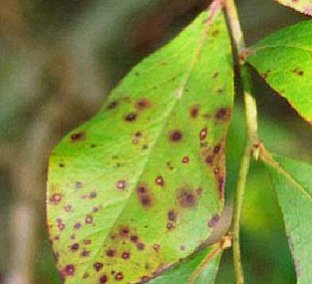
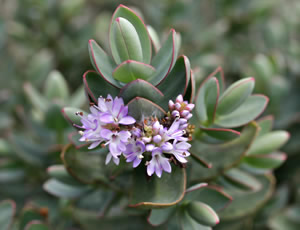
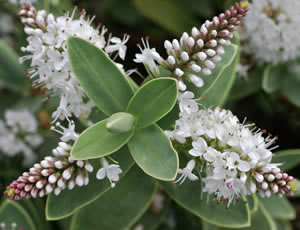
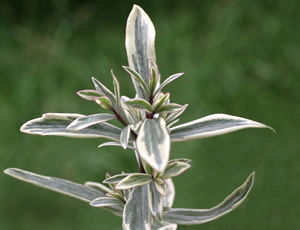
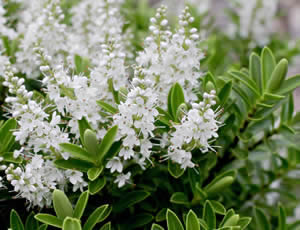
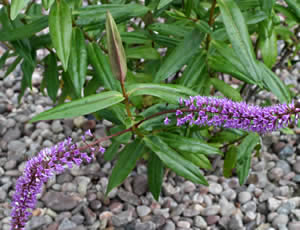
COMMENTS / QUESTIONS LEFT BY OUR READERS
ANSWER: Difficult, hebes are hardy down to -7C so it’s possible with your location and the exceptionally cold March we’ve had this year that they have been damaged beyond repair. I would say that if they haven’t greened up by mid May then remove them. But before you so, take a close up look at them for signs of recovery. Sometimes shrubs look done for at a distance but on closer inspection there may be signs of recovery. Leave them alone for the moment, if they show signs of recovery prune them back to the lowest two green shoots on each stem.
driveway? I worry in case the roots might penetrate the drive underneath the blocks which are set firmly on a sand base.
ANSWER: Every situation is different so I can only give general advice. The varieties which grow to around 3 foot tall or less are not known to cause damage to paths even when planted near them.
the Autumn and they haven’t shown any signs of new growth. I haven’t removed them just in case. I have pruned my mature Hebe ‘Albicans’ and found some stems had rooted in the ground so I have removed those and planted them in with the Hebes that may not have survived their ‘accidents’. I have used phostrogen for seedlings. They are in clay soil in a sunny position. Anything else I should do to help them? I reckon I have a 50/50 chance of one of the Hebes taking in this bed! Fingers crossed.
ANSWER: If you have clay soil I would simply make sure that they are watered if the ground becomes dry. You might want to mulch around them with compost or anything similar. This will help the ground maintain moisture and reduce any need for watering. Best of luck.
ANSWER: They will eventually fall off by themselves. Many people cut them off though, simply to allow as much light to get to the leaves below, reduce the risk of fungal diseases and just for appearance.
Thanking you in anticipation
ANSWER: I wouldn't advise trying to split a hebe. It has a fibrous root system which won't respond well to being cut in half. To get more hebe plants take cuttings.
ANSWER: Firstly, whatever pruning you decide to do, don’t do it now! Prune a hebe in early to mid Spring. The reason for this is that pruning too late in the year may still result in new buds forming but the winter cold will, in all probability, damage them severely before they have had time to harden up.
So the question then is, how to prune your hebe next spring? Hebes do not always spring back into life if you prune back into old wood which has no visible shoots from it. Often they just die. But the operative word is “often”, and that also means not always.
The decision therefore is up to you. But if you are going to dig up the plant I would suggest first pruning it back hard next spring and wait six months to see what happens. If it dies, nothing lost, if it springs back to life with a better shape, then excellent.
ANSWER: That’s quite normal for some Hebes. Both the flower and leaf colour can change during the season depending on weather conditions and the levels of light.